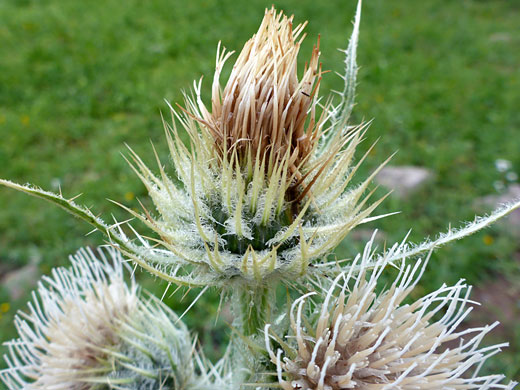
Cream-colored florets and green phyllaries of cirsium parryi - Arrastra Basin Trail, San Juan Mountains, Colorado
Common name:
Parry's thistle
Family:
Scientific name:
Cirsium parryi
Main flower color:
Range:
Arizona, Colorado and New Mexico
Height:
Up to 6 feet
Habitat:
Meadows, moist woodland, streamsides; 7,000 to 12,000 feet
Leaves:
Lanceolate to oblanceolate, up to 12 inches long and 2 inches across, with lobed or toothed edges
Season:
June to October
Cirsium parryi is an easy species to identify - it inhabits high, moist mountain slopes and meadows, produces several large flowerheads, clustered together, and its florets are colored yellow to very pale brown or nearly white, quite different to the pinks and purples of most thistles.
Flowerheads form at the tip of the stem branches and from the upper leaf nodes, and are subtended by narrow, spiny, lobed bracts; they are usually attached by stalks, of up to 1.5 inches, but may be sessile. Phyllaries are dark green in color, becoming brown with age, and their edges are lined with bristly or cobwebby white hairs. Phyllaries have a short spine at the tip and a lengthwise ridge down the middle. The corolla lobes of the ray florets are about half as long as the corolla tubes.
Leaves are variable in appearance; they may have wavy margins, toothed margins, or be shallowly or deeply lobed. The segments may themselves be lobed, or toothed. Lobes terminate in a sharp, straw-colored spine. Leaf surfaces have a sparse covering of soft or cobwebby hairs. Basal leaves are usually withered at flowering time.
Flowerheads form at the tip of the stem branches and from the upper leaf nodes, and are subtended by narrow, spiny, lobed bracts; they are usually attached by stalks, of up to 1.5 inches, but may be sessile. Phyllaries are dark green in color, becoming brown with age, and their edges are lined with bristly or cobwebby white hairs. Phyllaries have a short spine at the tip and a lengthwise ridge down the middle. The corolla lobes of the ray florets are about half as long as the corolla tubes.
Leaves are variable in appearance; they may have wavy margins, toothed margins, or be shallowly or deeply lobed. The segments may themselves be lobed, or toothed. Lobes terminate in a sharp, straw-colored spine. Leaf surfaces have a sparse covering of soft or cobwebby hairs. Basal leaves are usually withered at flowering time.
All Contents © Copyright The American Southwest | Comments and Questions | Contribute | Site Map




